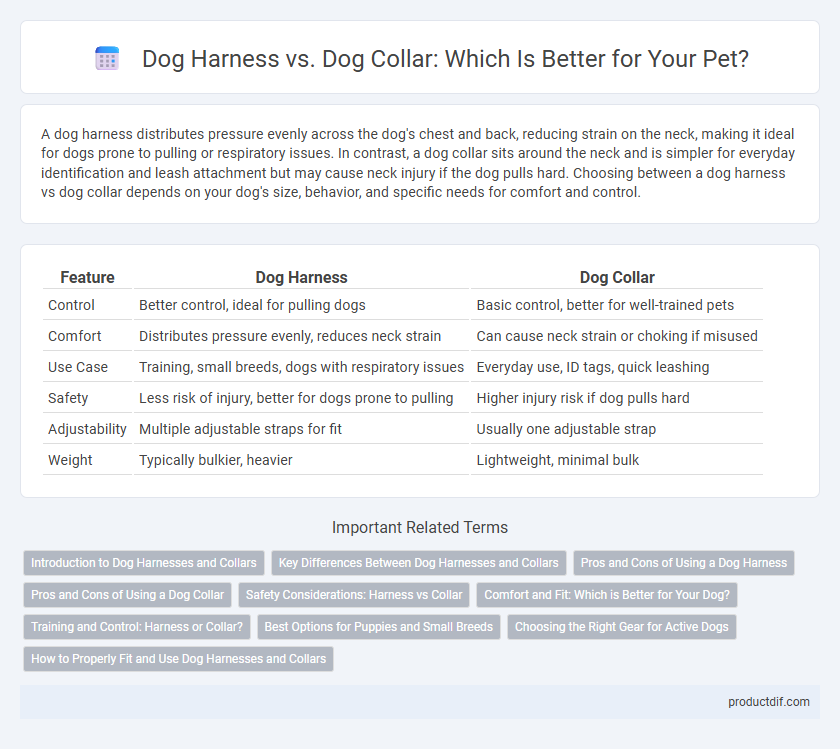A dog harness distributes pressure evenly across the dog's chest and back, reducing strain on the neck, making it ideal for dogs prone to pulling or respiratory issues. In contrast, a dog collar sits around the neck and is simpler for everyday identification and leash attachment but may cause neck injury if the dog pulls hard. Choosing between a dog harness vs dog collar depends on your dog's size, behavior, and specific needs for comfort and control.
Table of Comparison
| Feature | Dog Harness | Dog Collar |
|---|---|---|
| Control | Better control, ideal for pulling dogs | Basic control, better for well-trained pets |
| Comfort | Distributes pressure evenly, reduces neck strain | Can cause neck strain or choking if misused |
| Use Case | Training, small breeds, dogs with respiratory issues | Everyday use, ID tags, quick leashing |
| Safety | Less risk of injury, better for dogs prone to pulling | Higher injury risk if dog pulls hard |
| Adjustability | Multiple adjustable straps for fit | Usually one adjustable strap |
| Weight | Typically bulkier, heavier | Lightweight, minimal bulk |
Introduction to Dog Harnesses and Collars
Dog harnesses provide even pressure distribution across a dog's chest and back, reducing strain on the neck compared to traditional dog collars which encircle the neck. Harnesses are particularly beneficial for dogs with respiratory issues or those prone to pulling, offering enhanced control and comfort during walks. In contrast, collars remain suitable for attaching identification tags and basic leash control but may cause choking or injury if misused.
Key Differences Between Dog Harnesses and Collars
Dog harnesses distribute pressure evenly across a dog's chest and back, reducing strain on the neck compared to collars, which concentrate force on the throat. Harnesses offer more control for walking and are ideal for dogs prone to pulling or respiratory issues, while collars are simpler for ID tags and casual use. Choosing between them depends on a dog's behavior, health needs, and owner's control preferences.
Pros and Cons of Using a Dog Harness
Dog harnesses provide better control and reduce strain on a dog's neck compared to collars, making them ideal for training and dogs with respiratory issues. They distribute pulling pressure evenly across the chest, minimizing injury risks and enhancing comfort during walks. However, harnesses can be more cumbersome to put on, may cause chafing if not properly fitted, and often allow less freedom of movement than collars.
Pros and Cons of Using a Dog Collar
Dog collars provide a simple and effective way to display identification tags and attach leashes for everyday walks, offering convenience for routine use. However, collars can cause strain or injury to a dog's neck, especially for pets prone to pulling or respiratory issues. Unlike harnesses, collars may not distribute pressure evenly, increasing the risk of choking or throat damage during sudden pulls.
Safety Considerations: Harness vs Collar
Dog harnesses distribute pressure evenly across a dog's chest and back, reducing strain on the neck and minimizing the risk of tracheal injury compared to collars. Collars, while suitable for ID tags and lightweight control, may cause choking or neck damage if a dog pulls aggressively or during sudden movements. For enhanced safety, especially with small breeds or dogs prone to respiratory issues, harnesses provide better protection and control without compromising comfort.
Comfort and Fit: Which is Better for Your Dog?
Dog harnesses distribute pressure evenly across a dog's chest and shoulders, reducing strain on the neck and providing greater comfort for dogs prone to pulling or respiratory issues. In contrast, dog collars concentrate force around the neck, which can cause discomfort or injury if the dog pulls hard or frequently. For optimal fit and comfort, harnesses are generally better suited for active dogs or breeds with delicate necks, while collars may be sufficient for well-trained dogs with minimal pulling behavior.
Training and Control: Harness or Collar?
Dog harnesses provide better control during training by distributing pressure evenly across a dog's chest, reducing strain on the neck and preventing choking, especially for pullers or small breeds. Collars, while easier to put on and suitable for holding ID tags, can cause neck injury if used improperly during training or with strong-pulling dogs. Choosing a harness often enhances training effectiveness and safety, promoting better behavior control without discomfort.
Best Options for Puppies and Small Breeds
Dog harnesses provide better control and distribute pressure evenly, making them ideal for puppies and small breeds prone to neck injuries. Lightweight, adjustable harnesses with breathable materials ensure comfort and safety during walks. For gentle training and everyday use, padded collars with quick-release buckles offer a practical alternative.
Choosing the Right Gear for Active Dogs
Choosing the right gear for active dogs involves understanding the benefits of dog harnesses and collars. Dog harnesses offer better control, reduce strain on the neck, and prevent choking during vigorous activities like running or hiking. Collars are suitable for everyday use and identification but may not provide the same safety and comfort for highly active dogs.
How to Properly Fit and Use Dog Harnesses and Collars
Properly fitting a dog harness requires measuring your dog's chest girth and adjusting the straps to ensure a snug but comfortable fit without restricting movement or causing chafing. When using a dog collar, select one that fits two fingers' width under the neck to avoid choking or skin irritation, and avoid attaching retractable leashes to collars to prevent neck injuries. Harnesses distribute pressure evenly, making them ideal for dogs prone to pulling, while collars are better suited for holding ID tags and casual walks.
Dog Harness vs Dog Collar Infographic

 productdif.com
productdif.com